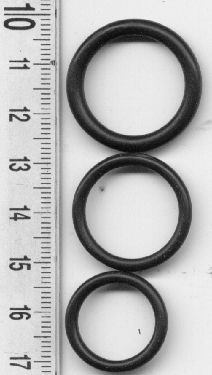O-ring
An o-ring is a rubber gasket with a round cross-section, and is usually used to create an airtight seal around moving parts, such as pistons and bolts. O-rings are cheap and come in a wide range of sizes. However they need to be mounted in a precisely machined groove for most applications, and a lathe is usually needed to achieve this, so they are not always a viable option.
An o-ring seal, when done correctly, can hold thousands of psi.
For those with a lathe, the process for machining an O-ring groove is:
- Chuck the workpiece well, ensuring that it rotates true.
- Gently measure the actual radial thickness of the O-ring.
- Using a cut-off tool or similar tooling that will produce a deep flat bottomed cut, cut a groove of the proper width to a depth that will put a 5-10% squeeze on the O-ring.
This depth can determined by the formula O*(100%-S%) - 1/2(OD - ID) Where O is O-ring thickness, S% is the percent of squeeze (higher percents make tighter O-ring seals), OD is the outside diameter of the interior part, and ID is the inside diameter of the exterior sleeve.
Putting the O-ring on the exterior sleeve is not recommended, as it is harder to machine and tends to fall out if the interior part fails to press against it. This article is a stub. You can help by expanding it
